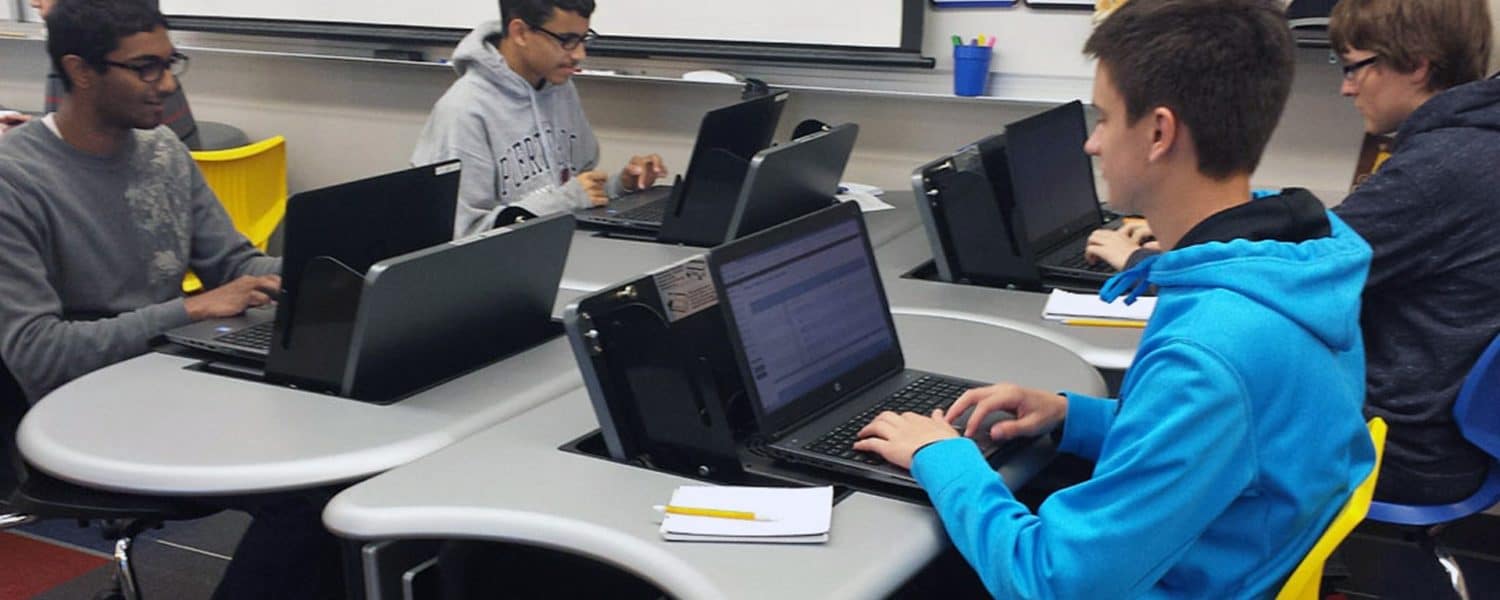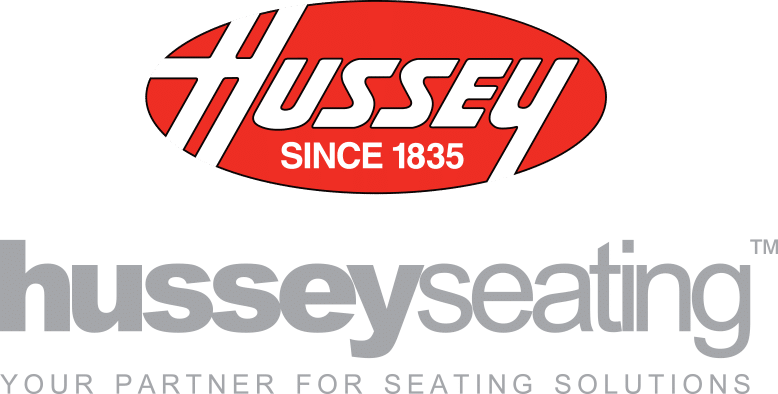By John Kessell
More than a decade ago, the buzzwords of collaborative learning, active learning, and video conferencing were not in widespread use in education. But as access to the Internet and computer technology in the classroom became practical, educators were drawn to these methods.
In higher education, the technology for presenting images and data visualization was being integrated into large classrooms. The furniture developed for the computer conference room became the “go-to” approach.
The innovation that made the first computer conference table possible was the multi-use monitor mount that converted a computer workstation to a standard desktop.
Developing the Multi-Use Computer Table
Dedicated computer labs, with rows and rows of screens, does not make an interactive, active learning space make. Flat screen displays, while optimal for computing usage, became deadly visual obstructions to the collaborative learning user experience.
We responded in 2003, developing furniture that incorporated our patented semi-recessed flip-up display. Our solution empowered users by making computer screens instantly in play, or out of the way.
With ergonomics in mind, our approach let users look slightly downward as if reading a book, instead of looking up at the screen. This resulted in reduced neck and eye strain, and it enabled unobstructed sight lines. And, desktops can quickly convert to simple work surfaces as the lesson plan changes.
Our next step was to inject this multi-use display strategy into interactive furniture design.
Geometry of Interaction
Conference tables are traditionally rectangular, so as well, one of the strategic flaws of a rectangular conference table is that it creates imbalance, intimidating the people on the long sides while empowering the individual at the head of the table.
People along the sides are faceless beyond the first couple of positions. Those with opposing opinions are often placed on opposite sides of the table, in confrontational body language.
The bottom line is that the rectangle tends to promote conflict, not collaboration. And how do you use desktop computers at a traditional conference table?
When we received a design request for a “line-of-sight” table, we began to rethink the approach with a triangular table. And rather than make computer use an afterthought, connectivity was designed into the table from the ground up.
A technology well, with a lid that opened like a baby grand piano, was designed in the center of the table. Components such as a speaker phone and small form factor CPUs could be placed in the well and retrieved for use, completely cabled-up, thanks to the wire pass-through between the lid and table top surface. And stations included our flip-up multi-use displays so participants could access computer screens and still establish eye contact while at the table.
As broadband Internet access became mainstream, AV technology was integrated into the space to enable video conferencing, expanding the scope of the meeting room to anyplace in the world. Initial installations were elaborate; some had three screens and three cameras to create a telepresence experience.
A bit expensive, the more affordable single camera video conference experience soon became the standard. Our triangular table was a natural fit for the single camera setup, as it allowed all participants to be seen in one field of view. Webcam and smartphone technology on the other side were soon enabled to meld with the single camera experience.
When the computer conference table wasn’t being used for a general meeting or video conferencing, it became a huddle space because the technology was generally there to support it.
Some clients were actually more interested in the furniture being used as a huddle space rather than a video conferencing area, so they requested that the size of the table and the video display be reduced.
Technology integrators specified HDMI switching technology that was intuitive to use so the users could focus on interaction. The huddle spaces were typically smaller than conference spaces.
Before long, the scale of the huddle tables made this category an option for active learning classrooms. Shifting from “teaching” to “helping students learn” incorporates collaboration, interaction, presentation, communication, and understanding.
The size of the classroom drives the types of physical groups to be accommodated, the visual learning supports to be used, and the information resources to be made available.
It leaves architects and designers with plenty to think about and plenty of opportunity for innovation, because somebody always has something new to bring to the party.
Shaping the Active Classroom Experience
We started thinking about how interactive groups could be put together to give optimum flexibility.
We started with shape. While many clients were only seeing the rectangle as the desk shape, and pushing these rectangles around to form groups, others sought to break out of that mold.
By our example, they were drawn to triangles and organic shapes to charge the space with interactive energy. In essence, interactive shapes for the classroom grew out of our proven collaborative design for the computer conference room.
Modular Table Elements that Make a Variety of Geometric and Organic Shapes
Our first foray into modular organic shapes for flexible arrangement looks like a surfboard. Inspired by the serpentine belt seen in airport luggage carousels, this initial design was manufactured in mirror image versions, featuring concave and convex ends that connect together.
The slip joints could be made into gentle arcs, clusters or straight rows. They were designed to be outfitted with multi-use computer workstations or laptop safes, allowing users access to technology on demand. The unique shape empowered educators to experiment with different activities.
Another organic shape approach was inspired by a flower: five petals surrounding a star-shaped technology hub “stamen.” The individual mobile laptop tables in the flower arrangement look like something that could take off for the skies.
The tables are height adjustable, allowing users to sit or stand for increased engagement. Some teachers use a station as a mobile podium/desk to move around to different whiteboards and displays in the space.
Right triangles become elements for even more flexible arrangements. Our experience indicates that people naturally form interactive pairs and trios around corners. These right triangle elements fit together like origami to form interactive shapes to suit the active learning goals of the space.
Six of a kind form radially symmetric shapes, such as pinwheels and hexagons. Three mirrored pairs form an equilateral triangle, a maple leaf, or abstracts. The arrangements charge the room with creative energy, engagement and productivity.
Units can be scaled larger to incorporate flip-up multi-use displays or all-in-ones, and can be scaled smaller for laptops and BYOD environments.
Finally, there’s the circle, which can be divided into organic shapes that drive engagement and tranquility for focus. The yin-yang design symbolizes energized balance. The nesting flow elements fit into the yin-yang to make an elongated conference table, or expand to make collaborative spaces.
When the circle is divided like a clover, singles and pairs team up around a central technology core that serves power and USB charging. Circular concepts work well in large digital commons areas to support informal group work or independent study.
What’s ahead? Our clients will tell us.
The educational content and objectives are always in the driver’s seat. The delivery system—the technology and the furniture—fade into the background, lest they become distractions, frustrations and obstacles to the flow of ideas, communication and understanding.
A team approach wins the day, when educators, interior designers, technology integrators and custom furniture design team collaborate to make each active learning space just a little better.
John Kessell is marketing | creative director at SMARTdesks and an editorial contributor on subject matter relevant to IT Integration-customized furniture for active learning and collaborative conference spaces, www.smartdesks.com.










